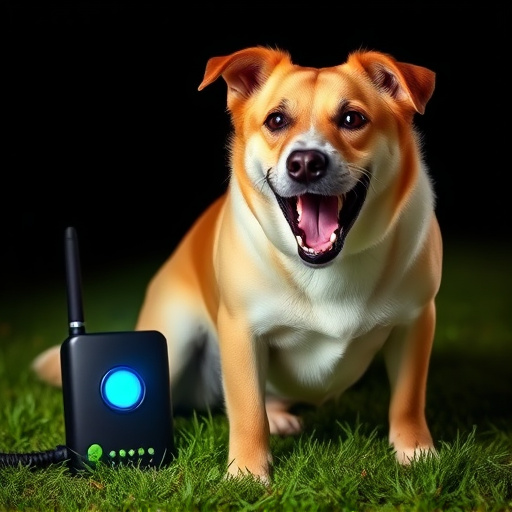Electronic pet deterrents, featuring Humane Training Modes, offer safe and effective behavior modification through sounds, vibrations, or light. Tailoring these modes to your pet's needs, adjusting sensitivity levels, and defining active areas maximize their efficacy. Regular monitoring and consistent positive reinforcement ensure successful training while prioritizing safety by following manufacturer guidelines.
“Discover the power of electronic pet deterrents, a modern solution for training and managing animal behavior. This comprehensive guide explores humane training modes, offering a gentle yet effective approach to discipline. We’ll uncover various types of electronic repellents and their adjustable settings, ensuring optimal performance tailored to your pet’s needs.
From safety precautions to ethical considerations, this article equips you with all the knowledge required to make informed decisions about using these innovative devices.”
- Understanding Humane Training Modes for Electronic Pet Deterrents
- Types of Electronic Repellents and Their Settings
- How to Set and Adjust the Device for Optimal Effectiveness
- Safety Precautions and Ethical Considerations for Using Electronic Pet Deterrents
Understanding Humane Training Modes for Electronic Pet Deterrents
Electronic pet deterrents have evolved beyond simple shock collars, incorporating advanced features and humane training modes to ensure safe and effective behavior modification. These modes use a range of stimuli, such as sounds, vibrations, or light, to encourage desired behaviors without causing physical harm. By understanding these humane training modes, pet owners can choose the most suitable repellent for their animals, promoting positive reinforcement while minimizing stress.
Unlike traditional punishment-based methods, electronic repellents with humane training modes aim to build a positive association with the target behavior through consistent and gentle cues. For instance, an electronic fence system might emit a beep when a pet approaches a boundary, encouraging them to stay put. This approach respects the animal’s autonomy while guiding them towards more appropriate conduct, fostering a stronger bond between owner and pet.
Types of Electronic Repellents and Their Settings
Electronic pet deterrents are a popular and effective way to train animals without resorting to harsh methods. These devices use various technologies to emit sounds, vibrations, or mild shocks to discourage unwanted behavior. One of the key advantages is their ability to offer humane training modes, ensuring pets aren’t harmed but rather learn through positive reinforcement.
The settings on these repellents are diverse and customizable. Users can adjust intensity levels for shock or sound, allowing for a tailored approach based on the pet’s sensitivity. Some models feature remote controls, enabling trainers to activate or deactivate the device from a distance. Additionally, time-based activation and deactivation options, as well as sensitive motion sensors, contribute to making these repellents versatile tools for managing pets’ behavior in different environments.
How to Set and Adjust the Device for Optimal Effectiveness
To achieve optimal effectiveness with an electronic pet deterrent, it’s crucial to properly set and adjust the device. Start by selecting the appropriate training mode tailored to your pet’s behavior. Humane training modes offer safe, non-violent solutions, such as gentle vibrations or audible beeps, which are effective in encouraging desired behaviors without causing harm. Adjust the sensitivity level based on your pet’s size and temperament; lower settings are suitable for smaller pets, while larger ones may require higher sensitivity to trigger the repellent effectively.
Next, determine the active area by considering the space where your pet is problematic. Most devices allow you to set specific zones; activate these zones according to your needs. Regularly monitor your pet’s response and make adjustments as necessary. Consistent use and timely reinforcement of positive behavior will enhance the device’s effectiveness, ensuring a well-behaved companion without resorting to harsher methods.
Safety Precautions and Ethical Considerations for Using Electronic Pet Deterrents
When using electronic pet deterrents, it’s paramount to prioritize safety precautions to ensure both pets and humans remain unharmed. These devices operate on mild electrical impulses, but proper measures must be taken to prevent accidental shocks or discomfort. Always follow manufacturer guidelines, ensuring the product is suitable for your pet’s age, size, and behavior. Regularly inspect the device for any signs of damage or wear, and never use if it seems faulty. Additionally, keep these deterrents out of reach from children to avoid any potential mishandling.
Ethical considerations also play a significant role in the use of electronic pet repellents. While they offer humane training modes compared to traditional punishment methods, their effectiveness can vary widely. It’s essential to understand that these devices are not one-size-fits-all solutions; their success depends on consistent and positive reinforcement training alongside the repellent. Regular monitoring and adjustments to settings are necessary to prevent overstimulation or unnecessary stress for your pet. Responsible use involves finding a balance between deterring unwanted behaviors and promoting positive, healthy interactions between pets and their environments.
In conclusion, electronic pet deterrents, when used responsibly and with an understanding of humane training modes, can be effective tools for managing unwanted behaviors. By selecting the right type of electronic repellent and adjusting its settings appropriately, pet owners can achieve optimal results while ensuring their pets’ safety and well-being. Always prioritize ethical considerations and follow safety precautions to create a harmonious living environment for both pets and humans.
